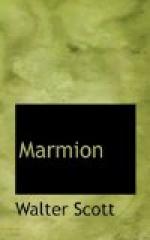Stanza I. line 1. ’The ruinous castle of Norham (anciently called Ubbanford) is situated on the southern bank of the Tweed, about six miles above Berwick, and where that river is still the boundary between England and Scotland. The extent of its ruins, as well as its historical importance, shows it to have been a place of magnificence, as well as strength. Edward I resided there when he was created umpire of the dispute concerning the Scottish succession. It was repeatedly taken and retaken during the wars between England and Scotland; and, indeed, scarce any happened, in which it had not a principal share. Norham Castle is situated on a steep bank, which overhangs the river. The repeated sieges which the castle had sustained, rendered frequent repairs necessary. In 1164, it was almost rebuilt by Hugh Pudsey, Bishop of Durham, who added a huge keep, or donjon; notwithstanding which, King Henry ii, in 1174, took the castle from the bishop, and committed the keeping of it to William de Neville. After this period it seems to have been chiefly garrisoned by the King, and considered as a royal fortress. The Greys of Chillinghame Castle were frequently the castellans, or captains of the garrison: Yet, as the castle was situated in the patrimony of St. Cuthbert, the property was in the see of Durham till the Reformation. After that period, it passed through various hands. At the union of the crowns, it was in the possession of Sir Robert Carey, (afterwards Earl of Monmouth,) for his own life, and that of two of his sons. After King James’s accession, Carey sold Norham Castle to George Home, Earl of Dunbar, for L6000. See his curious Memoirs, published by Mr. Constable of Edinburgh.
’According to Mr. Pinkerton, there is, in the British Museum. Cal. B. 6. 216, a curious memoir of the Dacres on the state of Norham Castle in 1522, not long after the battle of Flodden. The inner ward, or keep, is represented as impregnable:—“The provisions are three great vats of salt eels, forty-four kine, three hogsheads of salted salmon, forty quarters of grain, besides many cows and four hundred sheep, lying under the castle-wall nightly; but a number of the arrows wanted feathers, and a good Fletcher [i.e. maker of arrows] was required.”—History of Scotland, vol. ii. p. 201, note.
’The ruins of the castle are at present considerable, as well as picturesque. They consist of a large shattered tower, with many vaults, and fragments of other edifices, enclosed within an outward wall of great circuit.’—Scott.
line 4. battled = embattled, furnished with battlements. See Introd. to Canto V. line 90, and cp. Tennyson’s ‘Dream of Fair Women,’ line 220:—
’The valleys of
grape-loaded vines that glow
Beneath the battled
tower.’




